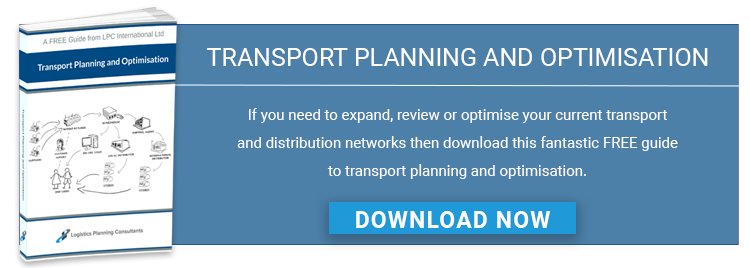
The purpose of this case study is to illustrate the following:
- Blue sky distribution network development.
- The universality of our modelling tool:
- Delivery units included pallets, oversized pallets, stillages and nested or stacked products, all converted into standard pallet footprint equivalents.
- Some products or customers required vehicles with mechanical offloading capability; others could be served with conventional flat beds.
- Vehicle overloading was a risk, so order weight was also used as a constraint
Background
This is a study for a regional supplier of construction materials operating from a single yard south of London that wished to establish a presence in the rest of the country.
The purpose of the study was to plot a road map that would allow the company’s growth into the remaining areas of the country where it had no presence using regional yards and its own fleet.
The Base Case
- The blue columns show the populations of postcode districts the company delivered into for the period modelled illustrating the business’s current delivery territory excluding distant outsourced deliveries.
- The columns’ height represents their percentage or share of the total population.
- 2,700 postcode districts are represented.
The First Stage
- The natural first stage is a Birmingham depot.
- 80% of the population can be reached within 3 hours’ drive from one depot or the other.
- The grey columns are regions beyond three hour’s drive from either depot.
- Each postcode district is attached to its nearest depot.
- Birmingham could reduce the load on the existing site as shown in the bar chart.
The Second Stage
- The natural second stage is a Leeds depot to be able to reach the North-East and reduce delivery resources and costs.
- 84% of the population can be reached within 3 hours’ drive from one depot or another.
- Delivery costs would decrease for the North.
- Similar volume is likely to be delivered from each depot to its area.
- The grey columns are regions beyond three hour’s drive from any depot
The Final Stage
- Adding Motherwell in Scotland will allow access to the final 8% of the population reachable within three hours’ drive.
- It would be the smallest site.
- The total population reachable would be 96%.
- Suppliers will charge a premium to deliver stock to Scotland.
The Recommendation
- The recommendation was for a three site solution. It would not be the cheapest from the transport point of view but:
- It would reach the bulk of the population of England and Wales and nearly the same as a four or five site solution (see bar chart above).
- It would benefit from the economies of scale from having three similarly sized sites.
- It would be less complex.
- It would be likely to be the cheapest network overall.
- It could be supplemented by Scotland eventually to reach 92% of the population.


